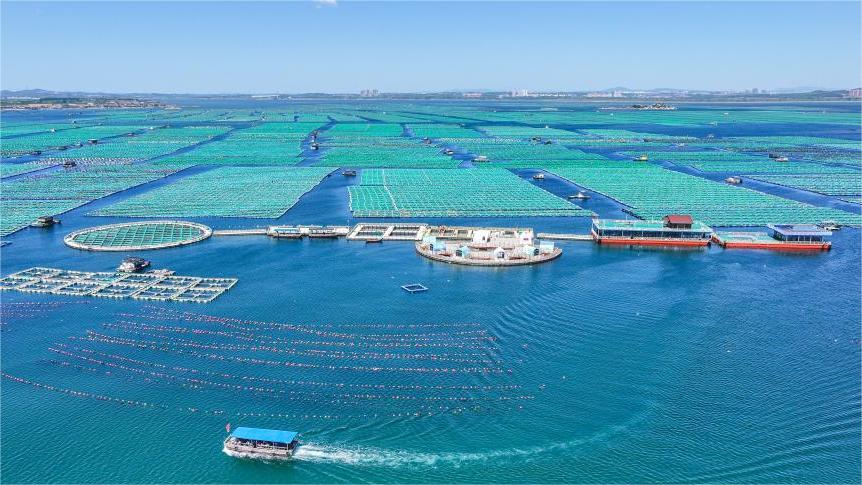Are tariff hikes on Chinese EVs a boon for America's green industry?
CHICAGO, May 16 (Xinhua) -- Amid concerns over the alleged threat posed by cheap Chinese electric vehicles (EV), the U.S. government announced on Tuesday a significant tariff hike on Chinese EVs, rising from 25 percent to 100 percent in 2024.
With the automobile industry's electrification progressing at a snail's pace, U.S. authorities are hoping to protect the domestic electric vehicle industry by blocking Chinese EVs.
However, industry insiders and experts argue that imposing tariffs will not accelerate the development of the U.S. EV industry, as the barriers to its progress stem from internal challenges rather than external factors. Instead, these new protectionist measures would eliminate the much-needed competition for American car manufacturers and impede a green transition in the United States.
Furthermore, the newly imposed tariff will increase costs for U.S. consumers, who will be deprived of access to affordable Chinese EVs. This may hinder their ability to transition to more environmentally friendly vehicles, consequently impacting the U.S. targets for mitigating climate change.
"Such imposts aren't just a barrier on the road to net zero: they're also a willful act of economic self-harm," said Bloomberg columnist David Fickling in a recent opinion piece.
STALLING ENERGY TRANSITION
After coming into office in 2021, the Biden administration had set an ambitious goal of achieving a carbon pollution-free power sector by 2035 and a net zero emissions economy by no later than 2050. The focus was on promoting EVs and EV battery production. For this purpose, the Biden administration has issued supporting measures, such as building charging stations and retraining workers.
On April 27, 2023, the U.S. Environmental Protection Agency (EPA) published proposed standards to further reduce harmful air pollutant emissions from light-duty and medium-duty vehicles starting with model year 2027. It projects that EVs could account for 67 percent of new light-duty vehicle sales and 46 percent of new medium-duty vehicle sales in 2032.
Nevertheless, according to Kelley Blue Book estimates, the EV share of the total U.S. new-vehicle market was only 7.6 percent in 2023, up from 5.9 percent in 2022 and 3.2 percent in 2021. Analysts of Cox Automotive expect EV share to increase year over year in 2024 to reach roughly 10 percent. The growth is far from meeting the EPA targets.
On March 20, 2024, the EPA issued its final automobile emissions standards, allowing the automotive sector more time to ramp up production for electric vehicles and other alternative fuel powertrains in the latter half of the decade than it would have under the previous proposal.
The final rules clarify that multiple pathways can be used to achieve compliance. EPA expects the mix of EVs, plug-in hybrids, hybrid electric vehicles and cleaner internal combustion engine vehicles to increase. It projects that from model years 2030 to 2032, manufacturers may choose to produce all-electric vehicles for about 30 percent to 56 percent of new light-duty vehicle sales.
Under the final rules, the total light-duty fleet standard for model year 2029 is 136 grams of carbon dioxide per mile, a nearly 50-percent decrease from model year 2026 and against the original proposal for the 2029 target of 111 grams per mile.
The broad return to a more mixed vehicle offering still assumes an all-electric future, but adoption is much slower than previously expected. The buzz around EVs is wearing off.
GROWING MISMATCH BETWEEN SUPPLY & DEMAND
U.S. EV sales in 2023 crossed the one-million-unit mark for the first time and increased about 52 percent compared with 2022. Despite the growth, only one in 10 new car registrations in the United States was electric in 2023, against more than one in three in China and over one in five in Europe.
There are about 3.3 million EVs on the road in the United States, according to an Experian Automotive Market Trends report from the fourth quarter of 2023, up from 2 million in 2022 and 1.3 million in 2021. However, overall, EVs account for just over one percent of the total light-duty vehicles currently on U.S. roads. There is still a long way to go before EVs catch up with gas-powered vehicles, which comprise the remaining 285 million vehicles currently operating.
Except for Tesla, all other U.S. automakers have seen disappointing EV sales. Ford Motor Co. used to pin great hope on the F-150 Lightning, an all-electric version of America's favorite F-150 pickup, but the sales have fallen significantly short of the company's projection.
Due to slowing demand for EVs, General Motors and Ford have postponed billions of dollars in investments in the past year as the two automakers have moved against additional production capacity. Tesla is also cutting prices. Apple has canceled all plans to release an autonomous electric vehicle, which it had been working on for over a decade at a cost of billions of dollars.
On the supply side, the average price paid for an EV in February was 52,314 dollars. Though higher inventory and increased competition have driven down the price premium of EVs, they remain priced above mainstream non-luxury vehicles by nearly 19 percent, according to Cox Automotive and Kelley Blue Book estimates.
With fewer EVs qualifying for tax incentives, EV sales may further stagnate.
Producing EVs is not cost-effective for U.S. automakers. With China taking the lead in the new energy industry, particularly the battery sector, many clean vehicle companies worldwide use China-made batteries. However, Tu Xinquan, dean of the China Institute for WTO Studies of the University of International Business and Economics in Beijing, told Xinhua that the U.S. government has forced enterprises to redirect their supply chains.
According to a newly published analysis from the Boston Consulting Group (BCG), legacy automakers are still losing thousands of dollars on EV sales. The group estimates that most automakers lose around 6,000 dollars on each EV they effectively sell for 50,000 dollars, and that price accounts for any tax credits or other consumer incentives.
Automakers will only be able to close about half of that cost gap with technology choices, BCG said.
On the demand side, America is a country on wheels, and its consumers generally prefer large vehicles, have range anxiety for EVs and are not ready to replace their orthodox cars with EVs.
Compared to Europe and Asia, America has vast land, abundant resources, and cheap fuel. The advantages of EVs are not particularly obvious here, Ni Pin, president of Wanxiang America Corporation, told Xinhua.
Meanwhile, America also lags in building charging stations. About 80 percent of respondents cited concerns about a lack of charging stations as a reason not to buy an electric vehicle, according to a 2023 survey from The Associated Press-NORC Center for Public Affairs Research and the Energy Policy Institute at the University of Chicago. Seven in 10 said they would not buy an EV because it takes too long to charge and the battery technology is lacking.
U.S. President Joe Biden signed a 5-billion-dollar National Electric Vehicle Infrastructure program into law in November 2021. But more than two years later, only four states, namely Ohio, New York, Pennsylvania and Hawaii, have opened stations funded by the program.
POLITICS PLAY A ROLE
As the U.S. presidential elections draw near, the Biden administration is bowing to the U.S. automotive industry and the United Auto Workers (UAW) by lowering the market share requirement of EVs. These groups represent a significant voting demographic in key swing states like Michigan, Pennsylvania and Wisconsin, where narrow margins have decided the overall winner of the past two presidential elections, local media reported. Both called for moderation in regulations in light of slowing growth in EV sales.
The Alliance for Automotive Innovation, which represents 42 automakers, including General Motors, Toyota Motor, Volkswagen and Hyundai, said the Biden administration's Average Fuel Economy proposal "exceeds maximum feasibility" and could cost automakers more than 14 billion dollars in non-compliance penalties between 2027 and 2032.
UAW President Shawn Fain announced in May 2023 that a reelection endorsement for Biden would be withheld until the UAW's concerns about the auto industry's transition to all-electric vehicles were addressed.
However, shortly after news leaked that the EPA had drafted final rules allowing additional time for the EV transition, the UAW endorsed Biden for reelection on Jan. 24, 2024.
The endorsement is crucial for any candidate looking to secure the swing state of Michigan. By Feb. 24, 2022, the Detroit-based UAW has more than 400,000 active members and over 580,000 retired members in the United States, Canada and Puerto Rico. The UAW has more than 600 local unions. The UAW currently has 1,750 contracts with some 1,050 employers in the United States, Canada and Puerto Rico.
Prevailing protectionism in the United States is another factor restricting EV development. It endows U.S. EV policies with politics, leading to trade discrimination policies against specific countries, including China. "De-risking" and "de-coupling" became frequent words in the transition to EVs.
The Inflation Reduction Act of 2022 (IRA) issued by the Biden administration prohibits certain clean vehicles from government subsidies.
IRA states that to qualify for the first 3,750-dollar tax credit, a portion of a vehicle's battery components must be produced or assembled in North America. To receive the second 3,750-dollar tax credit, a portion of the critical minerals used in the battery must be extracted or processed in the United States or in a country that is a U.S. free-trade agreement partner, or they must have been made from materials recycled in North America. Starting in 2024, vehicles with components from countries designated "foreign entities of concern" (FEOC) are no longer eligible for a tax credit.
Tax credits will be prohibited for the battery component requirement if the battery was manufactured or assembled by an FEOC, effective for vehicles placed into service after Dec. 31, 2023. Furthermore, the credit will be prohibited if the battery contains any critical minerals "extracted, processed, or recycled" by an FEOC after Dec. 31, 2024.
Beginning in 2025, the restrictions will widen to include any critical minerals, namely lithium, nickel, cobalt and graphite, in EV batteries extracted, processed or recycled by an FEOC. China is listed as an FEOC, given its lead in EV technology and rich mineral resources.
ACT OF ECONOMIC SELF-HARM
With the U.S. presidential elections looming, analysts believe the fresh tariffs on Chinese EVs serve more as a political maneuver than a substantive economic policy, which will have minimal impact on Chinese automakers but shield American car manufacturers from competition and impede their transition toward greener technologies.
"The action has implications for the 2024 presidential election, as Biden aims to bolster his image as being tougher and smarter on China than former President Donald Trump," noted an ABC News article on Tuesday.
This was echoed by electric vehicle journalist Jameson Dow, who recently published an opinion piece titled "Tariffs on China aren't the way to win the EV arms race -- getting serious on EVs is" on Electrek. "There is a large short-term factor to this decision: the U.S. election," he said, noting, "it does seem that, with anti-Chinese sentiment at an all-time high, any mention of China short-circuits a certain percentage of the electorate."
"The simplicity of 'China bad' is a lot more comforting and simple to accept, despite lacking nuance," he added.
There is a prevailing belief that the newly imposed tariff will exert little influence on China's EV industry. Although the U.S. tariff hike on Chinese EVs appears aggressive, its direct impact on China's EV exports "should be limited," according to a Morgan Stanley research.
According to the China Association of Automobile Manufacturers (CAAM), China shipped fewer than 75,000 vehicles to the United States in 2023, representing less than 2 percent of its total vehicle exports. Major original equipment manufacturers (OEM) like BYD are not planning to enter the U.S. market due to rising protectionism, said the research.
Reuters reported Monday that very few Chinese EVs have been exported to America. According to data from the China Passenger Car Association, Geely was the only Chinese automaker to export to the United States in the first quarter, with 2,217 cars.
Regarding the U.S. automotive industry, experts warn that the tariff increase, emblematic of rising protectionism within the nation, may foster a sense of complacency among American car manufacturers and stifle their drive toward technological advancement, ultimately diminishing their competitiveness on the global stage.
"Simply blocking out better options won't kick the West's industry into gear," said Dow. "On the contrary, it will make our industry more complacent. And we're already seeing that happening, as automakers keep begging governments to let them continue their unsustainable business models even as competition looms."
"I think it's clear that simply doubling the price of the competition isn't the best way to ensure U.S. auto stays competitive. It won't help U.S. consumers, it likely won't have a net positive effect on U.S. jobs (across sectors), it will lull industry into a false sense of security, it doesn't help the environment, and perhaps least important but still worth mention, it violates the oft-repeated-but-never-honestly-held principle that government should 'avoid picking winners and losers,'" he added.
Inu Manak, a fellow at the Council on Foreign Relations, a Washington-based think tank, shares this view. "You shouldn't have tariff protections because you're limiting the ability of your own market to become competitive," she was quoted as saying in an opinion piece by Bloomberg.
In another Bloomberg piece, Fickling said, "Like birds on isolated islands, America's carmakers are evolving to suit an oddly congenial environment -- one where they can grow big and bloated in the absence of competition from hungry rivals. Gradually, they'll lose the ability to fly."
Photos
Related Stories
Copyright © 2024 People's Daily Online. All Rights Reserved.









